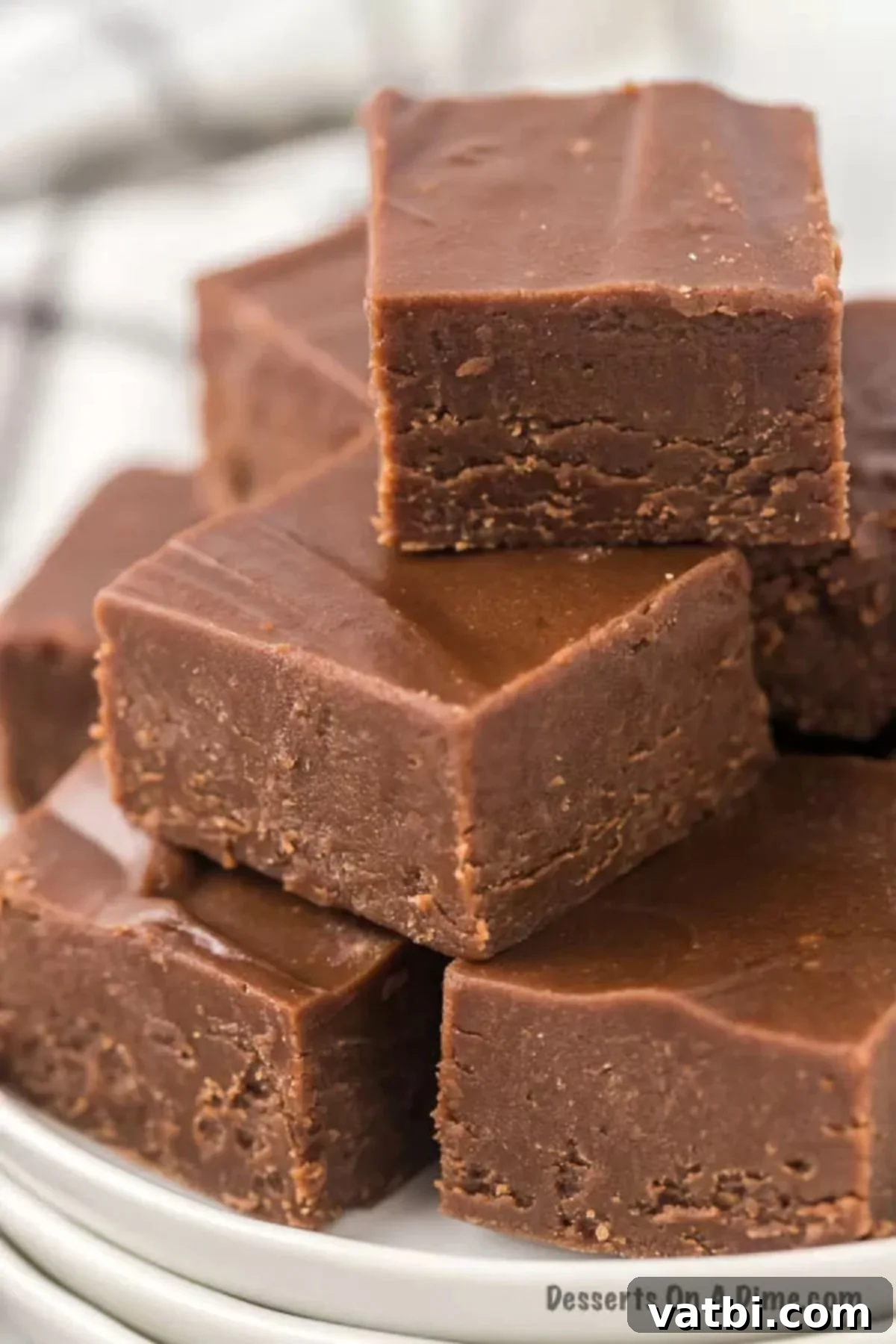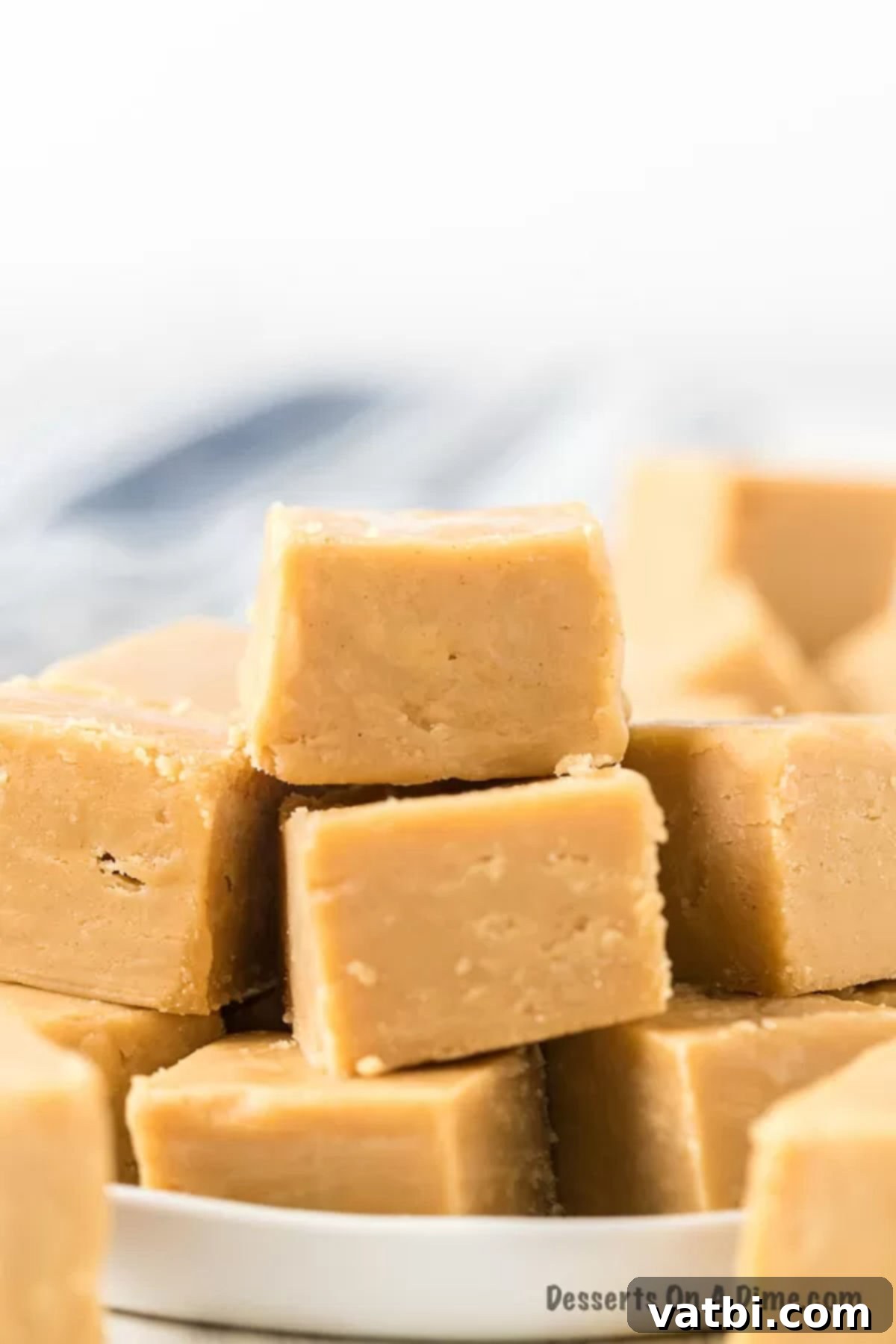How to Perfectly Freeze Fudge: A Comprehensive Guide to Preserving Freshness and Flavor
Fudge, with its irresistibly creamy texture and rich, decadent flavor, is a beloved treat. Whether it’s a holiday staple or a homemade delight, you might often find yourself with more fudge than you can enjoy in one sitting. This leads to a common question for many home bakers: Can You Freeze Fudge? The answer is a resounding yes! And in this ultimate guide, we will show you the simple, yet crucial, steps to freeze fudge successfully, ensuring it retains its delightful taste and texture for months to come.

Making easy fudge recipes, especially for festive occasions like the holidays, often results in a generous batch. Given its rich and sweet nature, it’s quite common to have delicious leftovers. The magical combination of sweetened condensed milk, high-quality chocolate chips, and other delightful ingredients creates a truly decadent experience. Learning how to properly freeze your fudge is a game-changer, allowing you to easily serve it later without compromising its creamy taste and perfect texture. This preservation method means you can enjoy that fresh-made quality anytime you desire a sweet indulgence.
If you’re eager to explore new fudge flavors, consider making crowd-pleasers like the Easy Vanilla Fudge Recipe, refreshing Lemon Fudge, or the visually striking Tiger Butter Fudge Recipe. All of these varieties are incredibly easy to freeze, making them perfect candidates for long-term storage. Imagine the rich taste melting in your mouth, tasting as if it was just prepared, even months later. Plus, many fudge recipes are surprisingly simple to whip up, often requiring just a microwave and a few basic ingredients.
Table of contents
- Why We Love to Freeze Fudge
- Benefits of Freezing Fudge
- Supplies for Freezing Fudge
- How to Freeze Fudge Step-by-Step
- How to Thaw Frozen Fudge
- Frequently Asked Questions About Freezing Fudge
Why We Love to Freeze Fudge
Freezing fudge is an incredibly simple and rewarding practice. By following these straightforward steps, you can extend the enjoyment of your favorite sweet treat throughout the entire year. Fudge is the ultimate dessert for satisfying a sweet tooth, but it’s often associated primarily with the holiday season. Thanks to effective freezing techniques, you’re no longer limited to seasonal indulgence; you can now savor this delightful treat anytime you crave it. The ability to preserve different types of fudge means they will retain their rich, creamy, and flavorful characteristics even after an extended period in the freezer. You’ll absolutely adore the convenience and long-lasting freshness that comes with freezing these tasty, sweet treats.
Benefits of Freezing Fudge
Beyond simply extending shelf life, freezing fudge offers a multitude of advantages for any dessert lover or home baker:
- Enjoy Year-Round: No longer are you restricted to making fudge only during the holidays. Freeze your extra batches and have a ready supply for any occasion or spontaneous craving throughout the year.
- Prevent Waste: Fudge recipes often yield large quantities. Freezing allows you to save any leftovers that might otherwise go stale, ensuring every delicious piece is savored.
- Convenience and Ready-to-Serve: Having pre-portioned, frozen fudge means you always have a quick dessert on hand for unexpected guests, school lunches, or a personal treat. Simply thaw and enjoy!
- Maintain Freshness and Texture: When frozen correctly, fudge retains its signature creamy texture and rich flavor, tasting remarkably fresh even after months. Proper freezing prevents it from drying out or becoming crumbly.
- Budget-Friendly Baking: Make large batches when ingredients are on sale, then freeze for later. This can be a cost-effective way to enjoy homemade fudge without constant trips to the grocery store.
- Gift Giving: Frozen fudge makes an excellent impromptu gift. Thaw a batch, package it beautifully, and you have a thoughtful, homemade present ready in no time.
Supplies for Freezing Fudge
To successfully freeze your fudge and maintain its exquisite quality, you’ll need a few essential items. Gathering these supplies beforehand will streamline the process and ensure your fudge is perfectly preserved.
- Sharp Knife. A sharp knife is crucial for cutting clean, even slices of fudge. This prevents crumbling and ensures each piece thaws uniformly. Avoid using dull knives, which can tear the fudge and create an uneven surface that is more susceptible to freezer burn.
- Plastic Wrap. This will be your first line of defense. Plastic wrap creates a tight seal around each individual piece of fudge, preventing air exposure which is the primary cause of freezer burn and moisture loss. Ensure it adheres snugly to the fudge.
- Aluminum Foil. Following the plastic wrap, aluminum foil provides an additional layer of protection. It acts as a barrier against light, odors, and further safeguards against freezer burn. The double wrapping method is key to optimal preservation.
- Wax Paper (Optional). While not strictly essential for wrapping individual pieces, wax paper is excellent for separating layers of wrapped fudge within a freezer bag or container. This prevents pieces from sticking together, making it easier to grab just one or two servings.
- Freezer Bag or Freezer-Safe Container. You have options here depending on your preference and freezer space. A heavy-duty freezer bag allows you to remove excess air, making it very effective for preventing freezer burn. Freezer-safe containers, on the other hand, offer more rigid protection, which is ideal if you’re worried about the fudge being crushed by other items in the freezer. Whichever you choose, ensure it’s airtight.
- Label Stickers or a Permanent Marker. This step is often overlooked but is incredibly important for organized freezing. Labeling your freezer bags or containers with the type of fudge and the date it was frozen will help you easily identify contents and track how long it’s been stored, ensuring you enjoy it within its optimal timeframe.
Having these supplies ready will make the freezing process smooth and effective, allowing you to confidently store your fudge for future enjoyment.
How to Freeze Fudge Step-by-Step
Freezing fudge properly is a straightforward process that will ensure your delicious treat remains fresh and flavorful for an extended period. Follow these steps meticulously for the best results:
- Step 1. Cut into Individual Slices. Before you begin the wrapping process, make sure your fudge has completely cooled and set. Then, using a sharp knife, cut the fudge into individual servings or smaller blocks. Our freezers are often not large enough to accommodate an entire pan of fudge, and cutting it into smaller portions offers several benefits. Firstly, individual slices defrost much faster, allowing you to enjoy a quick treat without waiting hours. Secondly, it enables you to thaw only the amount you need, minimizing waste and ensuring the remaining fudge stays frozen and fresh. Aim for consistent sizes for even thawing.
- Step 2. Wrap Individual Slices. This is a critical step for preventing freezer burn and preserving the fudge’s creamy texture. Place each individual slice of fudge on a piece of plastic wrap. Wrap it tightly, ensuring there are no air gaps or exposed surfaces. The goal is to create a snug, airtight seal. After the plastic wrap, wrap each piece again with aluminum foil. This double wrapping provides an extra layer of protection against air, moisture loss, and any odors from other items in your freezer. This two-layer approach is your best defense against dreaded freezer burn, which can dry out and alter the texture of your fudge.
- Step 3. Place in Freezer Bag or Container. Once each piece is double-wrapped, carefully place the individual slices into a heavy-duty freezer bag or a freezer-safe, airtight container. If using a freezer bag, press out as much air as possible before sealing it tightly. This minimizes air exposure within the bag, further protecting your fudge. If you’re using a container, ensure it has an airtight lid. For added protection or to prevent pieces from sticking together, you can also place a sheet of parchment paper between layers of wrapped fudge within the container.
- Step 4. Label. Do not skip this step! Labeling is essential for an organized freezer and for ensuring you consume your fudge within its optimal storage time. Use a label sticker or a permanent marker to clearly write the type of fudge (e.g., “Chocolate Walnut Fudge”) and the date it was frozen on the freezer bag or container. This way, you’ll know exactly what you have stored and when it needs to be enjoyed by, preventing mystery items in the back of your freezer.
- Step 5. Place in Freezer. Carefully place the labeled freezer bag or container into your freezer. For the first 12-24 hours, it’s best to lay the bag or container flat. This allows the fudge to freeze solid in its desired shape, preventing it from being squashed or deformed by other items. Once the fudge is completely frozen solid, you can then stack other items on top of it or arrange it more compactly to save space in your freezer. Ensure your freezer maintains a consistent temperature of 0°F (-18°C) or lower for optimal long-term storage.
How to Thaw Frozen Fudge
Thawing frozen fudge correctly is just as important as freezing it properly to ensure it retains its original taste, texture, and creaminess. Rushing this step can lead to a dry or crumbly texture and unwanted condensation.
- Step 1. Transfer to the Refrigerator. When you’re ready to enjoy your frozen fudge, the first and most crucial step is to transfer the wrapped fudge from the freezer to your refrigerator. It is imperative that you do not thaw fudge at room temperature on the counter, in a cupboard, or in the pantry. Thawing slowly in the refrigerator prevents rapid temperature changes, which can cause excessive condensation to form on the fudge. This condensation can lead to a sticky exterior and can compromise the texture, making it less creamy and more watery. Keeping it wrapped during the initial thawing also helps to minimize moisture loss and protect against fridge odors.
- Step 2. Allow Sufficient Thawing Time. To maintain the perfect consistency of your leftover fudge, you must allow ample time for it to thaw completely and gradually. For individual slices or smaller blocks, the fudge will typically need about 2 to 4 hours in the refrigerator to fully thaw. Larger blocks or a significant quantity of fudge might require 4 to 6 hours, or even overnight, depending on their size and thickness. Resist the urge to speed up the process. A slow thaw is key to preserving that melt-in-your-mouth texture. You can gently press on a piece of fudge (through the wrapping) to check if it has softened throughout.
- Step 3. Ready to Serve and Enjoy. Once your fudge has thoroughly thawed in the refrigerator, it’s almost ready for serving. Remove the freezer bag or container of fudge from the refrigerator. Unwrap each piece of fudge from its foil and plastic wrap. For the absolute best flavor and texture, allow the unwrapped fudge to sit at room temperature for about 15-30 minutes before serving. This brief period allows the flavors to fully develop and the fudge to achieve its optimal creamy, soft consistency. You’ll find that the fudge should taste and have the consistency as if you had just made it, proving that proper freezing and thawing techniques truly work wonders. Arrange the pieces on a pretty cookie tray or serving platter and delight your family and friends.

Frequently Asked Questions About Freezing Fudge
Proper freezer storage is essential for maintaining the quality of your fudge. After you’ve prepared the fudge by cutting it into individual slices and double-wrapping each piece (first in plastic wrap, then in aluminum foil), place these wrapped pieces into a heavy-duty freezer bag or an airtight freezer-safe container. To ensure the fudge maintains its shape and doesn’t get squashed, lay the bag or container flat in the freezer for the first 12-24 hours until the fudge is completely solid. Once frozen solid, you can then stack other items on top or arrange your fudge more compactly. Always ensure the packaging is as airtight as possible to prevent freezer burn and absorption of other freezer odors.
When stored properly using the double-wrapping and airtight container method, the shelf life of fudge in the freezer is approximately 3 months. Beyond this period, the fudge will generally still be safe to eat, but its quality, particularly its texture and flavor, might begin to degrade slightly. For the best possible taste and consistency, aim to consume your frozen fudge within this 3-month window. This longevity makes freezing an excellent option for managing holiday baking overflow or preparing treats in advance.
Fudge can dry out for several reasons. One common cause is improper storage, especially if it’s exposed to air for too long, whether at room temperature or in the freezer. Air exposure causes moisture to evaporate, leading to a crumbly, dry texture. Another reason could be issues during the fudge-making process itself, such as overcooking the mixture, which can remove too much moisture, or incorrect ratios of ingredients (e.g., too much sugar, not enough fat or condensed milk). To prevent dryness, always ensure your fudge is stored in an airtight container or double-wrapped when not being served or when being frozen. When thawed, let it come to room temperature to help restore its creamy texture, and for slightly dry fudge, a few seconds in the microwave can sometimes soften it up.
Absolutely, you can freeze homemade fudge with excellent results! In fact, freezing is an ideal way to preserve the fresh taste and creamy texture of your homemade creations. After your homemade fudge has cooled completely and set, it’s best to slice the entire batch into individual servings. This allows each piece to be properly wrapped in plastic wrap, followed by a layer of aluminum foil, before being placed into a freezer-safe bag or airtight container. Storing fudge as individual slices makes it incredibly convenient to pull out just a small portion whenever you’re ready for a treat. If homemade fudge is stored properly using these methods, it will last up to 3 months in the freezer. For comparison, homemade fudge typically lasts about 2 to 3 weeks when stored at room temperature in an airtight container. With proper freezing, your homemade fudge will taste just like it was freshly made.
Yes, you can absolutely freeze fudge that contains nuts. However, for the best results, I recommend stirring the nuts directly into the fudge mixture while it’s still warm and before it sets. This way, the nuts are fully incorporated and protected within the fudge itself. If nuts are simply sprinkled on top of the fudge after it has set, there’s a higher chance they may fall off, become brittle, or lose some of their texture during the freezing and thawing process. If you prefer nuts on top, you might consider adding them fresh after the fudge has been thawed and is ready to serve for optimal crunch and presentation.
Freezing fudge is a simple yet effective way to extend the life of your favorite sweet treat. By following these easy steps, you can ensure that every piece retains its perfect creamy texture and rich flavor, ready to be enjoyed whenever a craving strikes.
Most Popular Fudge Recipes
Easy Candy
3 Ingredient Peanut Butter Fudge
Easy Candy
Easy Vanilla Fudge Recipe
Easy Fudge
Lemon Fudge
More Freezer Tips
Once you’ve mastered the art of freezing fudge, you’ll be eager to apply these valuable preservation techniques to other delicious treats. Expanding your freezer knowledge means you can enjoy a wider variety of homemade desserts for longer, reduce food waste, and always have something special on hand. Explore these additional freezer tips to become a true master of dessert preservation:
- Can you freeze cupcakes
- Can you freeze cake pops
- Can you freeze Banana Pudding?
- Can you Freeze Sweet Potato Pie
- Can You Freeze Pound Cake
Get started freezing fudge today and revolutionize your dessert storage! We’d love to hear from you. Leave a comment below and share your favorite tips or any successful freezing stories.
Print
Can you Freeze Fudge?
Equipment
-
Sharp Knife
-
Plastic Wrap
-
Aluminum Foil
-
Freezer Bag or Airtight Freezer-Safe Container
-
Label Stickers or Permanent Marker
Materials
- Prepared Fudge
Instructions
-
Cut the fudge into individual pieces once it has completely cooled and set.
-
Wrap each individual piece tightly in plastic wrap, then wrap again with aluminum foil to prevent freezer burn and keep air out.
-
Place the double-wrapped individual slices into a freezer bag or an airtight freezer-safe container, removing as much air as possible.
-
Label the freezer bag or container with the type of fudge and the date it was frozen for easy identification and tracking.
-
Lay the labeled package flat in the freezer to freeze solid, then store for up to 3 months.
